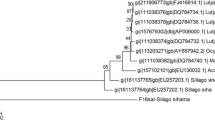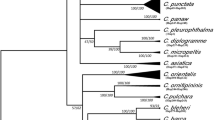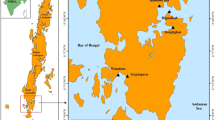Abstract
Mitochondrial DNA, cytochrome oxidase-1 gene sequences were analyzed for species identification and phylogenetic relationship among the very high food value and commercially important Indian carangid fish species. Sequence analysis of COI gene very clearly indicated that all the 28 fish species fell into five distinct groups, which are genetically distant from each other and exhibited identical phylogenetic reservation. All the COI gene sequences from 28 fishes provide sufficient phylogenetic information and evolutionary relationship to distinguish the carangid species unambiguously. This study proves the utility of mtDNA COI gene sequence based approach in identifying fish species at a faster pace.



Similar content being viewed by others
References
Sivakami S, Vivekanandan E, Raje SG, Sobha JK, Rajkumar U (2003) Lizardfishes, Pomfrets and Bullseye. In: Joseph MM, Jayaprakash AA (eds) Ststus of exploited marine fishery resources of India. Central Marine Fisheries Research Institute, Kochi, pp 141–157
FishBase (2004) FishBase. World Wide Web electronic publication www.fishbase.org
Kasim HM (2003) Carangids. In: Joseph MM, Jayaprakash AA (eds) Ststus of exploited marine fishery resources of India. Central Marine Fisheries Research Institute, Kochi, pp 66–75
Hebert PDN, Cywinska A, Ball SL, de Ward JR (2003) Biological identifications through DNA barcodes. Proc R Soc Lond B Biol Sci 270:313–321. doi:10.1098/rspb.2002.2218
Hebert PDN, Ratnasingham S, de Ward JR (2003) Barcoding animal life: cytochrome c oxidase subunit1 divergences among closely related species. Proc Royal Soc B 270(Suppl.1):S96–S99
Khan MZ (2000) The fishery and resource characteristics of pomfrets. In: Pillai VN, Menon NG (eds) Marine fisheries research and management. Central Marine Fisheries Research Institute, Kochi, pp 364–373
FAO (1974) Species identification sheet for fishery purposes. Eastern Indian Ocean (fishing area 57) and Western Central Pacific (fishing area 71) vol 1 (eds Fischer W and PJP Whitehead) pp C1–22
Sambrook J, Fritsch EF, Maniatis T (1989) Molecular cloning: a laboratory manual, 2nd edn. Cold Spring Harbor Laboratory Press, Cold Spring Harbor, NY
Ward RD, Tyler S Zemlak, Bronwyn H Innes, Peter R Last, PDN Hebert (2005) DNA barcoding Australia’s fish species. Philos Trans. R Soc B 360:1847–1857
Sanger F, Nicklen S, Coulson AR (1977) DNA sequencing with chain terminating inhibitors. Proc Natl Acad Sci USA 74(12):5463–5467. doi:10.1073/pnas.74.12.5463
Chen EY, Seeburg PH (1985) Supercoil sequencing: a fast and simple method for sequencing plasmid DNA. DNA (2):165–170
Bermington E, Lessios HA (1993) Rate variation of protein and mtDNA evolution as revealed by sea urchins separated by the Istmus of Panama. Proc Natl Acad Sci USA 90:2734–2738. doi:10.1073/pnas.90.7.2734
Kimura MA (1980) Simple method for estimating rate of base substitutions through comparative studies of nucleotide sequences. J Mol Evol 16:111–120. doi:10.1007/BF01731581
Kumar S, Tamura K, Jackobson IB, Nei M (2004) MEGA3.1: Integrated software for molecular evolutionary genetics analysis and sequence alignment. Brief Bioinform 5:150–163. doi:10.1093/bib/5.2.150
Rozas J, sanchez-DelBarrio JC, Messeguer X, Rozas R (2006) DNA sequence polymorphism version 4.10.9
Felsinstin J (1993) PHYLIP (Phylogeny Inference Package) version 3.50 Distributed by the author. Department of Genetics, University of Washington, Seattle, USA
Bernardi G, Robertson DR, Clifton KE, Azurro E (2000) Molecular systematic, zoogeography and evolutionary ecology of the Atlantic parrotfish genus Sparisoma. Mol Phylogene evol 15(2):292–300
Bensasson D, Zhang DX, Hertl DL, Hewitt GM (2001) Mitochondrial pseudogenes: evolution’s misplaced witnesses. Trends Ecol Evol 16:314–321. doi:10.1016/S0169-5347(01)02151-6
Honebrink Randy R (2000) A review of the biology of the family Carangidae, with emphasis on species found in Hawaiian waters. DAR technical report 2000–2001, Department of Land and Natural Resources 1151 Punchbowl Street, Honolulu, Hawai, pp 1–43
Lakra WZ, Goswami G, Gopalkrishnan A (2008) Molecular identification and phylogenetic relationships of seven Indian Sciaenids (Pisces: Perciforms, Sciaenidae) based on 16S rRNA and cytochrome C oxidase subunit I mitochondrial genes. Mol Biol Rep 216. doi:10.1007/s11033-008-9251-1
Santos S, Schneider H, Sampaio I (2003) Genetic differentiation of Macrodon ancylodon (Sciaenidae, Perciformis) populations in Atlantic coastal waters of South America as reveled by mtDNA analysis. Genet Mol Biol 26(2):151–161. doi:10.1590/S1415-47572003000200008
Vision C, Grazielle G, Scheneider H, Sampaio I (2004) Sciaenidae fish of the Caete river estuary, Northarn Brazil: mitochondrial DNA suggests explosive radiation for the Western Atlantic assemblage. Genet Mol Biol 27(2):174–180
Hebert PDN, Penton ErinH, Burns JohnM, Janzen DanielH, Hallwachs Winnie (2004) Ten species in one: DNA barcoding reveals cryptic species in the neotropical skipper butterfly Astraptes fulgerator. Proc Natl Acad Sci USA 101:14812–14817. doi:10.1073/pnas.0406166101
Hajibabaei M, Gregory A, Singer C, Hickey DonalA (2006) Benchmarking DNA Barcodes: an assessment using available primate sequences. Genome 49:851–854. doi:10.1139/G06-025
Hebert PDN, Barrett RDH (2005) Reply to the comment by L. Prendini on ‘Identifying spiders through DNA barcodes’. Can J Zool 83:505–506. doi:10.1139/z05-026
Acknowledgments
This work has been carried out at Centre for Cellular and Molecular Biology, Hyderabad during the training programme sponsored by Department of Biotechnolgy, Government of India. We thank the Commissioner of Fisheries A.P, Hyderabad and Principal SIFT, Kakinada for nominating for the DBT training. The constant help and encouragement of K. Mujumdhar, Deputy Director, CCMB is greatly acknowledged. We are thankful to Dr. Lior David for critical reviewing and improving the manuscript quality.
Author information
Authors and Affiliations
Corresponding author
Rights and permissions
About this article
Cite this article
Persis, M., Chandra Sekhar Reddy, A., Rao, L.M. et al. COI (cytochrome oxidase-I) sequence based studies of Carangid fishes from Kakinada coast, India. Mol Biol Rep 36, 1733–1740 (2009). https://doi.org/10.1007/s11033-008-9375-4
Received:
Accepted:
Published:
Issue Date:
DOI: https://doi.org/10.1007/s11033-008-9375-4




